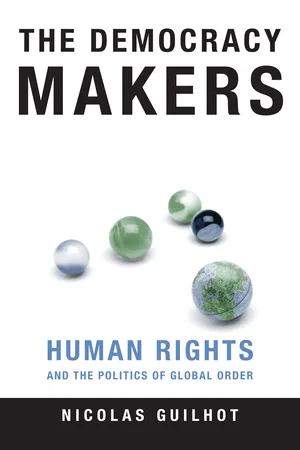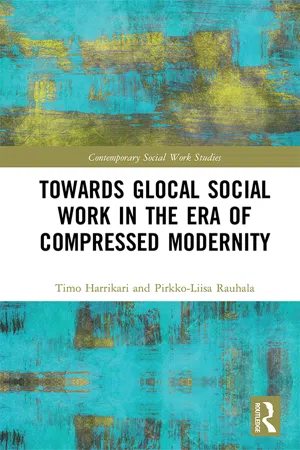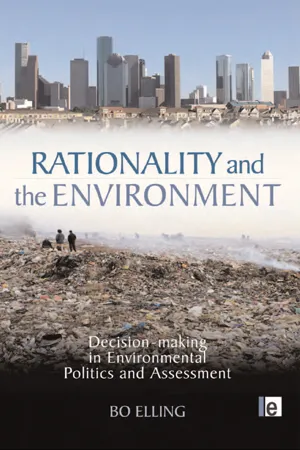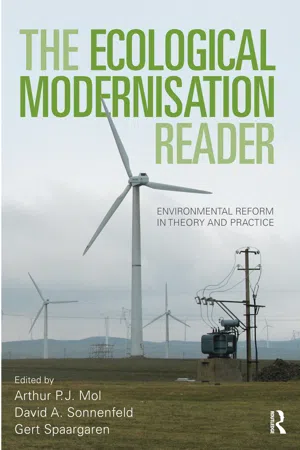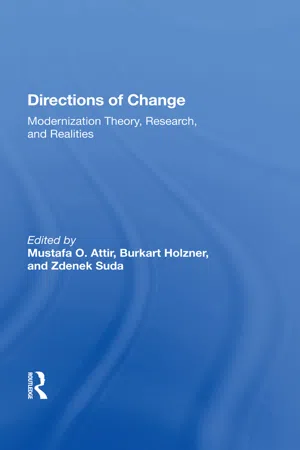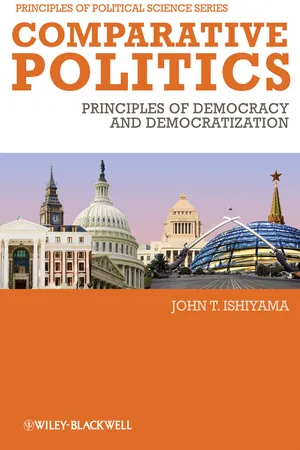Social Sciences
Modernisation Theory
Modernisation Theory is a perspective that emerged in the mid-20th century, aiming to explain the process of societal development in non-Western countries. It suggests that traditional societies can progress through stages of modernisation by adopting Western values, technology, and institutions. The theory has been critiqued for its ethnocentric assumptions and oversimplification of complex social change processes.
Written by Perlego with AI-assistance
Related key terms
10 Key excerpts on "Modernisation Theory"
- eBook - ePub
The Sociology and Politics of Development
A Theoretical Study
- Baidya Nath Varma(Author)
- 2010(Publication Date)
- Routledge(Publisher)
5 The sociological theories of modernizationSociologists consider modernization as a special case in the larger process of social change. In the voluminous literature existing today, they have no doubt examined some of the general aspects of modernization as sketched out in our model. For instance, in the field of economic growth, they generally concern themselves with the building of the economic institution and its interrelations with other institutions. National leadership, the development of the educational system, the role of labor unions, and entrepreneurship are some of the key topics with which they are concerned. In the field of political development, they emphasize the difficult facets of nation-building, such as the development of mass media and communications, popular participation in the political process, the growth and viability of the executive, legislative, and judicial branches of the government, the extension of a national legal system, the creation of consensus for public decision making, and similar problems connected with the functioning of the national polity.The literature on social reconstruction is also extensive. It deals with the development of bureaucracy, the viability of planning and action programs, as well as with the shift from the rural to the urban milieu of a growing number of people, and consequent changes in class structure, urban pathologies, population pressures, and so on. The demands of the populace in the modernizing nations are fed by vocal interest groups, which often compete with the interests of the elite which is entrenched in power. The issues of equality, fraternity, and the enhancement of basic freedoms and opportunities highlighted in our model are related to the rise of new ideologies and reform movements. Many theoretical as well as speculative works exist on these topics. - eBook - ePub
- Peter Preston(Author)
- 2012(Publication Date)
- Routledge(Publisher)
41 ] we will pursue in Part III when we look at the work of Streeten. Here we can simply note that within economics at this stage the slide from economics understood as the manipulation of formal machineries towards economics taken as actually involved in the world is under way. The distinction between economic growth theories and theories of social and economic change grows increasingly blurred; it is to the latter that we now turn.4.0 Dynamic of Theory Ii: ‘Modernization Theory', A New Master Scientist
Theories of social and economic change constitute our second area of substantive interest carried over from the previous chapter. Now whilst there these matters were touched upon very briefly and almost in passing, here we trace the emancipation of the broad range of the social sciences from their early status as ‘under-labourers’ to economics. In general we can say that where chapter 3 traced the construction and deployment of ‘growth models’, in this chapter we see the resources of a wider set of disciplines being plundered for elements which might flesh out a theory of ‘modernization’.4.1
With regard to the origins of ‘modernization theory’, Tipps makes the very general observation that its origins can be placed in ‘the response of American political elites and intellectuals to the international setting of the post Second World War era’.[42 ] Indeed, he goes on to say that this was the first time that substantial resources had been deployed in making systematic sense of the world beyond the US borders. This surge of interest presented social scientists with novel demands, and we are offered a quasi-Kuhnian explanation for the variety of conceptual schemes offered. They provided ‘surrogates for a tradition of inquiry into the problems of these societies which was almost entirely lacking’. [43 ] Without an established literature, theorists plundered their disciplines' histories in search of a general paradigm. So ‘modernization’ is ‘deeply rooted in the perspective of developmentalism’, claims Tipps , [44 ] citing Nisbet.Further sociology of knowledge information on the genesis of ‘modernization’ may be found in Tipps's ideological critique of the thesis. A résumé of the criticisms of ‘modernization’ is begun by noting the charge of ethnocentricity. The modernization theorists talk of ‘traditional’ and ‘modern’ where nineteenth-century evolutionists, from whom comes ‘modernization's’ theoretical underpinning, spoke of ‘civilization’ and ‘barbarism’. This is deemed to be a cosmetic change; ‘modernization’ remains a style of evaluation which measures a society's progress/status by ‘its proximity to the institutions and values of Western, and particularly Anglo-American, societies’.[45 - Elena Barabantseva(Author)
- 2010(Publication Date)
- Routledge(Publisher)
The portrayal of modernisation in predominately economic-numerical form is striking. They are even reflected in a trend observed by some studies on contemporary visual representation and official propaganda. One such study by Landsberger concluded that, in the official discussions of the 1980s and early 1990s, there was an almost complete dominance of Western symbols of progress (Landsberger 1993: 188). In the 1980s to 1990s many writings largely undermined the functional approach in social science and disputed the linear conception of universal historical process. These writings are easily accessed in China and, in fact, have influenced a number of mainland scholars (Wang Hui 2003: 141–87). Nevertheless, the dominant scholarly research continues to see modernisation as an evolutionary process, with economics and technological innovations at its core. The modernisation discourse is formulated around Western theories, while earlier Chinese studies, with their underlying emphasis on the interaction between technology and spirit, are made irrelevant. The transformation of the socio-political and cultural systems, which are more inert than the economy when it comes to radical systemic changes and present one of the greatest challenges to the communist regime, remains largely ignored by the Second Modernisation Theory. The production of China’s official national project is informed by the linear vision of history evolving along the development progress, the simplistic interpretation of culture, and the somewhat passive and uncritical acceptance of the experiences in some Western societies as the only legitimate source of development knowledge. China’s official formulations of its development process not only have become rooted in and dependent on the Western orthodoxies, but also have produced a generalised vision of the West that suppresses difference within China.China as a map of the history of civilisation
The Second Modernisation Theory is presented as a contribution by Chinese scholars to general theories of modernisation, but it is also presented in essentially Chinese national terms. He Chuanqi utilises China’s national geo-body to draw an analogy with the global modernisation process. He specifically refers to the Yangtze River that flows from the west to the east, which, he argues, spatially illustrates the temporal progression of civilisation and world modernisation: ‘From the upper to the lower reaches, the levels of both development and civilisation rise (despite fluctuations). The process of this change is logical, and is highly similar to the process of world modernisation’ (He Chuanqi et. al 2007: 106, see Figure 3.1 ). It is interesting to note that traditionally the Yellow River in the north has been presented as a cradle of Chinese civilisation and the birthplace of the Chinese nation. The Yellow River often serves as a symbol of the Chinese nation in scholarly, literary and popular accounts. But He’s reference to the Yangtze River is employed for a different purpose. While it illustrates China’s unique development model, according to He, it also invites an analogy with China’s progression through the whole history of civilisation known to humanity. In He Chuanqi’s words, ‘As if human civilization had flowed from the upper reaches, to the middle reaches, to the lower reaches, and to the estuary. We call this phenomenon the Yangtze River Model of the long history of human civilization’ (He Chuanqi et al.- eBook - ePub
Political Development Theory
The Contemporary Debate
- Richard Higgott(Author)
- 2005(Publication Date)
- Routledge(Publisher)
2From Modernisation Theory to Public Policy: Continuity and Change in the Political Science of Political DevelopmentIt was argued in Chapter 1 that the study of underdevelopment has been marked by a polarisation into two broadly based schools of thought. Despite the recognised weakness of applying such dichotomous classifications, such an approach enables us to discuss not only those debates that exist between schools of thought, but also within those schools of thought and, perhaps more importantly, the processes of transformation that each school has undergone over time. What follows in this chapter, therefore, is an exposition and critique of the recent non-Marxist literature on the politics of development in an effort to establish the clear links that exist between Modernisation Theory of the 1960s and that work which throughout the 1970s has come to emphasise public choice and policy analysis in the broader context of a ‘new political econom’. Sticking closely to the historiographical form of analysis outlined in Chapter 1 , it will be argued that: (1) the research of the 1970s reflects a greater deal of continuity (both conceptual and methodological) with the earlier work than is often assumed, (2) efforts to incorporate or accommodate the early inadequacies of Modernisation Theory have not been successful, and (3) much of the recent literature raises substantial problems in its own right.It is neither possible nor necessary to review Modernisation Theory here; its general characteristics, guides to primary sources in the field and critiques are to be found in numerous survey articles (Bernstein 1971; Frank 1971; Tipps 1973; Higgott 1978). Rather, the intent is to examine the recent literature of North American political science concerned with political development, no matter how the concept is defined. Such a focus allows us to trace the critiques, reactions and modifications to Modernisation Theory over the last two decades. Consequently, the first section of this chapter, borrowing on the work of Robert Packenham (1973) and Ronald Rogowski (1978), delimits a simple threefold classification of political science: legal formalism, behaviouralism and post-behaviouralism. The emphasis is on the second period and what is seen as its transformation into the third. For the purpose of this discussion a further division is also required. The literature of political development, as an integral part of behavioural political science, has been divided into two subsections: that produced between the mid-1950s and the mid-1960s and between the mid-1960s and 1971. - eBook - ePub
The Democracy Makers
Human Rights and the Politics of Global Order
- Nicolas Guilhot(Author)
- 2005(Publication Date)
- Columbia University Press(Publisher)
Modernization as a Disciplinary StakeThe involvement of the foreign policy establishment in the scientific field certainly reflected the social proximity and the increasing interactions between academic research centers and policymakers. But it also corresponded to a real need for planning tools in foreign policy and especially in foreign aid, designed to facilitate economic modernization and avoid its political hazards. The group of John Kennedy’s advisors in charge of long-term development aid—the so-called “Charles River” group, mostly recruited from MIT and Harvard—symbolized this search for “more specific, quantitative criteria for assistance” (Packenham 1973: 62) that would underlie the work of development agencies such as AID or the World Bank during the whole decade. With its stress on quantification, operationalization, and testability, modernization theory provided the perfect scientific ideology for a growing development technocracy that sought to combine a faith in technocratic solutions and a commitment to social reformism dictated as much by political convictions as by strategic pragmatism (Dezalay and Garth 2002). Progressive social reform was indeed a central component of the U.S. strategy toward the developing world. To the extent that achieving “take off” and reducing the “explosiveness of the modernization process” required not only economic inputs but also social change—land reform, tax reform, more voluntary organizations, greater political participation (Packenham 1973: 62), the cold war policy of modernization entailed the promise of more democracy, social improvement, and individual well-being. The multiple agents of this policy—a swelling body of technical advisors, development engineers, administrators, and social scientists—could legitimately consider themselves as the agents of a benevolent social reformism. This professional group was therefore endowed with moral attributes by a techno-political discourse functioning both as a standard of scientificity and as an emancipatory ideology. In the words of a leading exponent of modernization theory, “the problem of the American serving abroad is no longer that of representing American power but of learning how to be effective in helping others to achieve their ambitions of development” (Pye 1966: 4).Reflecting the perception of the world from the standpoint of U.S. foreign policy planners and institutionalized in academic institutions that benefited from the financial support of the philanthropic foundations, modernization theory appears as a socially situated research program, in spite of the emphasis it placed on objectivity, formalism, value-free concepts and in spite of its apparent universality. As a recent assessment notices, “since it was American social scientists at elite academic institutions who contributed disproportionately to ‘modernization analyses,’ the model of modernization was to an important extent an unreflexive projection of the liberal, secular, individualizing values of ‘establishment’ intellectuals.” (Tiryakian 1991: 170).This context certainly was propitious to the establishment of modernization theory as a dominant research agenda. And it certainly explains the capacity of modernization theory to function as a political ideology, legitimating development policies and transforming the U.S. socioeconomic model into a universal one. What it cannot account for, however, is the capacity of this paradigm to function also as “science.” The massive financial investments sustaining the growth of area studies and comparative politics do not explain the capacity of modernization theory to impose successfully its methods as scientific standards and to impose a semblance of conceptual unity over “area studies.” In other words, while this academic agenda suited the purposes of the foreign policy establishment, that did not mean that it was apt to play the role of a real scientific paradigm in an academic environment. Michael Latham is right when he argues that the ideology of modernization functioned as a political weapon “in one surface-level sense,” but that “it was also a cognitive framework that crystallized an underlying, firmly-held set of beliefs” (Latham 1998: 205–6). - eBook - ePub
Towards Glocal Social Work in the Era of Compressed Modernity
Towards an Era of Distorted Modernity
- Timo Harrikari, Pirkko-Liisa Rauhala(Authors)
- 2018(Publication Date)
- Routledge(Publisher)
Thus, the Western changes have been constructed as narratives which have led either to affirmative or to critical conclusions, due to varying research objects, contexts and data. The analyses have attempted to describe large-scale developments and capture deep generative mechanisms leading to the transformation. As we see it, the narratives are dependent upon the conceptualisations presented as well as the discourses chosen. Thus, our ability to develop any up-to-date theory depends on conceptualising phenomena in a stimulating way and searching for the theory’s place among the previous conceptualisations. We are aware that it has been suggested that the concept of modernisation should be abandoned, as it has been considered speculative, due to its diversity and looseness. No doubt, when presenting large-scale developments in a small space, there is a clear risk of over-interpretation, but we would like to keep this concept as a starting point for setting our discourse, as it is broad and loose enough for our analysis.Setting the conceptual agenda for ‘an individual in a situation’
In relation to social theory, three key dimensions frame the concept of modernisation – agency/structure, temporality and spatiality. The first dimension refers to the possibilities and constraints of human activity, the second one to the events, episodes, durations and rhythms of social action in communities and the third to spatiality, especially the extents and interconnections between social systems, institutions and regions. These conceptual choices demonstrate our ontological and epistemological approach, which is critical realist (e.g. Danermark et al. 2002). Of course, it would have been possible to tie our thoughts more clearly to the post-structural approach and avoid such things as difficulties in defining the concept of structure. However, as we see it, there is a real, intransitive world outside our perceptions (ontological realism), but we may propose various transitive conceptual networks to capture its phenomena and mechanisms (epistemological relativism).The dynamics of agency and structure
First of all, we would like to return to Mary Richmond’s premise, ‘there is an individual in a situation’. The premise declares explicitly the intertwining of the concepts of agency and structure. In this regard, the most important questions address what the concepts of ‘agency’ and ‘structure’ are, how they are related and what their scopes of application are. While extending this setting and, further, formulating it as the red line throughout our work, we need to ask what are the identities of Richmond’s ‘individual’, what are the degrees of freedom of any individual and what types of ‘situations’ or ‘circumstances’ — in other words, systems, structures and ecologies, and enabling and constraining agencies — surround the individual. - eBook - ePub
Rationality and the Environment
Decision-making in Environmental Politics and Assessment
- Bo Elling(Author)
- 2012(Publication Date)
- Routledge(Publisher)
Incidentally, such a distinction is not easy to sustain. Buttel (2000) stresses that the concept of ecological modernization encompasses an ample range of usages, and identifies four different forms of application: (a) sociological theories of ecological modernization; (b) a portrayal of dominant environmental political discourses; (c) synonymously with environmental management, industrial ecology, eco-reconstruction and so on; and (d) an expression of nearly every innovation in environmental policy or environmental improvement. However, what really matters, according to Buttel, is that the explosive growth in the interest in ecological modernization does not stem from clarity in the theoretical arguments of this line of thinking, but from ecological modernization being an effective answer to a series of circumstances and imperatives in the socio-ecological thinking of the 1990s.In the social sciences, it was seen as necessary to react to the rising influence of radical environmentalist movements, particularly to assess whether radical environmental activism would become a dominant factor of power in society and a necessary forerunner to effective environmental improvements and reforms. Moreover, the concept of sustainable development – which initially seemed so promising to the social sciences – began to manifest its shortcomings regarding the indication of visions for future evolutions and environmental policies. The concept of sustainability was originally developed in a North–South dialogue against the background of experiences concerning primary and renewable sectors in the non-city or rural settings of developing countries. In this context, the concept of ecological modernization provided a platform for new thinking concerning the problems and their solutions, which were mostly related to sectors being transformed in cities in advanced industrial nations. Finally, the advocates of ecological modernization, unlike radical environmentalists, saw the role of environmentalist movements from a fresh perspective by refraining from romanticizing them, and by appreciating the elementary roles that science, technology, capital and the state could play in the processes of environmental innovation. - eBook - ePub
The Ecological Modernisation Reader
Environmental Reform in Theory and Practice
- Arthur P.J. Mol, David A. Sonnenfeld, Gert Spaargaren, Arthur P.J. Mol, David A. Sonnenfeld, Gert Spaargaren(Authors)
- 2020(Publication Date)
- Routledge(Publisher)
Three schools of thought were identified as relevant to the sociological contribution to the environmental debate. One tradition works from a Marxist perspective and deals with the treadmill of production as the main cause of disturbances in the sustenance base; another school highlights the industrial dimension of modernity in analyzing environmental deterioration; and a third emphasizes the counterproductivity of the development of modern society. We conclude that there is a lack of sophisticated theories dealing explicitly with the relationship between institutional developments of modern society—whether it be capitalism, industrialism, or another development—and the burdening of the sustenance base in all three schools of thought. In that sense, environmental sociology is still in itsOne of the recent sociological theories dealing explicitly with the relationship between modernity and environment has given some attention to these issues: ecological modernization. The popularity of this theoretical concept is based on its close correspondence with the idea of sustainable development, combined with recent changes in environmental policy and dominant ideologies of the environmental movement in some Western European countries.The theory of ecological modernization is limited insofar as it deals with only the industrial dimension of modernity, neglecting dimensions of capitalism and surveillance, and because it narrows the concept of nature to the sustenance base. On this last issue, ecological modernization is consonant with most of the other relevant contributions to the debate on environment and modernity, which also ignore, to a large extent, intuited nature. We think the distinction between the two dimensions of nature, intuited nature and scientific nature, might fruitfully be further theorized. We only indicate the general direction of analysis here. In the first place, elaborating on intuited nature would necessitate an emphasis within environmental sociology on themes that, to a certain extent, have been left in the hands of philosophers and social psychologists up to now, specifically, the ways human actors deal with nature, its integrity, its intrinsic value, and its value for human agents. In the second place, and in our opinion essential for environmental sociology in the near future, it would mean giving high priority to the analysis of the risk profile (Beck, 1986; Dietz and Frey, 1992; Giddens, 1991) of modern society and the way people handle this dimension of the environmental crisis within their everyday lives. - eBook - ePub
Directions Of Change
Modernization Theory, Research, And Realities
- Mustafa O. Attir(Author)
- 2019(Publication Date)
- Routledge(Publisher)
It would be a gross error to underestimate the significance of the specific meanings which individual socioeconomic systems attribute to modernization, as some oversimplified interpretations on the part of adherents of convergence theory would seem to suggest. The purpose and meaning of the process of social change, as it is experienced and perceived by the relevant strata of a given society, may have little effect in changing the merciless realities of the natural environment, insufficient resources, or low ranking of a society on the international stratification ladder, but they are nevertheless very important. This is especially true, as we shall see, for the evaluation by the society of the system’s performance, as well as for the attribution by individual actors of the responsibility for their success or failure in life. Yet the refusal to admit the universal character of modernization, i.e., its cross-cultural impact and requirements, means that policies introduced in the belief that the situation of the society is unique and that the decision makers have it firmly in hand will have unanticipated effects.Curiously enough, this very assumption of complete control over the society and the environment makes Marxist-inspired or religiously motivated modernizing elites rather similar to elites in other countries and testifies to the universality of the modernization phenomenon. The professed goals, and especially the rhetoric, may be distinctive in either case, but there are two basic shared assumptions. The belief that the task of constructing a new social reality will be successfully accomplished indicates a belief in the “feasibility of the world.” It makes the position of the elites in the communist party-states or fundamentalist religious societies no different from that of elites in other regions of the world who are committed to modernization and who call their objective by its true name. The attitudes of both are part of what can be defined as the modern frame of mind. The other shared assumption is less philosophical in nature, but it is of equal significance: the presumed inexhaustibility of resources, natural as well as human. It is obvious that the success of the modernization enterprise on a world scale can be taken for granted only if this premise is accepted. Until the energy crisis of the 1970s, material means to development had never been perceived as a major problem; belief in their abundance was an article of faith that, although seldom spelled out, made of the modernization-oriented leaders in the whole world a single informal sect. - eBook - ePub
Comparative Politics
Principles of Democracy and Democratization
- John T. Ishiyama(Author)
- 2011(Publication Date)
- Wiley-Blackwell(Publisher)
What is the relationship between economic development and “modernization,” on the one hand, and the emergence of political democracy, on the other? This is a central question addressed by what many now refer to as “modernization theory.” Modernization theory is less a coherent theory than an approach to how economic modernization is related to political development. Although rooted in a longstanding literature in sociology, modernization theory in political science grew out of the behavioral revolution’s desire to focus on factors outside of institutions to explain political development (as discussed in Chapter 1). It is rooted in many of the older sociological approaches associated with socialist thought (in particular, Karl Marx) but also the classic works of Emile Durkheim and Talcott Parsons.The idea that economic development has a direct effect on political development is not new. Many scholars historically have noted the profound social changes that resulted from industrialization. Indeed, basic principles associated with modernization theory are derived from the Age of Enlightenment, particularly the “human-centric” notion that people can control and change their environment. The eighteenth-century French philosopher Marquis de Condorcet was one of the first to argue that the rise of technology and economic transformation would enable humankind to make changes in their moral and cultural values and that economic development would make enormous improvements in the state of human affairs and that technological progress would allow for the promotion of social progress. Early socialist thinkers at the beginning of the industrial era in the nineteenth century, such as Henri de Saint-Simon (1760–1825), also emphasized the positive power of economic development and technology in enabling humanity to better its social conditions. Saint-Simon’s student, Auguste Comte (1798–1857) thought of modernization and technology as empowering humans in a new scientific or “positive” era where science and technology would fundamentally alter the human condition. Such was also the perspective of Karl Marx in his critique of capitalism, when he noted that industrialization of the economic base had fundamentally changed the social and political superstructure, that is, that economic changes created the conditions for social and political change.One of the earliest scholars to systematically examine the impact of economic transformation on the evolution of social structures and societal development was the French scholar Emile Durkheim. Durkheim is considered one of the founders of modern sociology and a pioneer in comparative social science. He is one of the first to develop the idea of “functionalism,” an idea later incorporated into theories of structural functionalism (as discussed in Chapter 1). Essentially Durkheim thought of all societies as having functions that needed to be performed (such as security, political leadership, spiritual leadership, etc.) and what differentiated societies was the degree of complexity in the division of labor in how these functions were performed. Durkheim thought that societies evolved in ways similar to biological organisms, in stages from simple to complex. These changes were necessitated by changes in the surrounding environment, and in the modern era the primary environments were the economic and cultural environments. In “primitive” societies, he argued, relatively little complexity was needed to maintain social order. However, with industrialization and the development of capitalism, societies became more complex, and more functional differentiation and a more complex division labor were needed to maintain social order. He stressed that the major transition from a primitive social order to a more advanced industrial society could bring about crisis and disorder. Durkheim is associated with the concept of social anomie
Learn about this page
Index pages curate the most relevant extracts from our library of academic textbooks. They’ve been created using an in-house natural language model (NLM), each adding context and meaning to key research topics.



